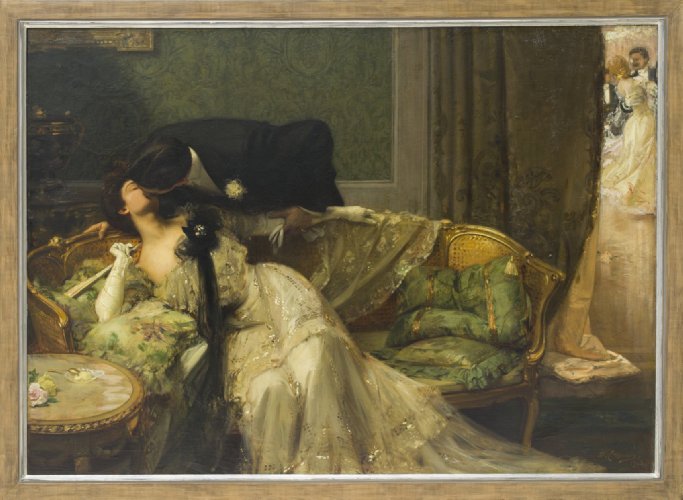Description:
Hubert Denis Etcheverry (1867-1952) was a French genre painter, portraitist and very good draftsman of Belle Époque. He studied at the École Municipale de Dessin in Bayonne and then at the École des Beaux-Arts in Paris with Léon Bonnat and Albert Maignan. He started with historical and mythological scenes. His painting “Jupiter and Mercury” received the second prize at the exhibition in Rome in 1891. However, the peak of Etcheverry’s creativity was the turn to genre painting and anecdotal scenes from the life of the bourgeoisie at the turn of the century *.
Description of the picture:
This painting “Frenzy” made Hubert Denis Etcheverry famous. It is a typical example of the Salon painting, depicting melodramatic and often controversial scenes from the life of the French bourgeoisie. The term “salon painting” refers to European art presented officially at the annual Paris exhibition – the Salon. Being accepted to take part in it was the beginning of the road to fame for many artists, and the receipt of a gold medal at the exhibition was the crowning of their artistic career. “Frenzy” adorned the Salon in 1903. All of Paris was talking about it. It is difficult to determine what endeared it more to its supporters, the intriguing title of the work, or the sensual, hallway scene presented in it.
The artist takes us to a cozy parlor located right next to the ballroom. In the foreground a couch has been painted on. On it a young woman has sunk her body, who came here for a moment to rest and taste the delicacy on the table. Her cream dress was decorated with a black lace pin with a brooch. The outfit is completed with long white gloves and a folded fan held in the right hand. Just behind the mysterious stranger a man in a black tailcoat was painted. He removed the gloves from his hands. He leaned over the lady, touched her forearm and kissed her lips. The face of the young man was not shown. He also hides the features of his companion. The parlor was separated by a curtain, a porter from the couples dancing on the right. It seems that we hear the sound of a melody that fills the interior.
The duality of representation is evident in the opposition of two spaces. Public and private, official and intimate. Play and rest. Music and silence. Movement and rest. Conventions and secret meetings breaking them. The multitude of characters and pairs of lovers. With a clear emphasis on the dominance of the second element, whose depiction has taken over the work. What’s more, the title “Frenzy” emphasizes that it is precisely the private, intimate sphere that is the most exciting, captivating the senses, in which one can completely lose oneself.
Thanks to such a composed scene, the viewer seems to be watching an intimate date of two lovers, bathed in a delicate golden light reminiscent of the light of candles. It transcends the knowledge inaccessible to most of the characters depicted in the painting. It becomes a kind of intruder who, on the one hand, satisfies curiosity, but on the other hand is aware of the inappropriateness of its presence.


